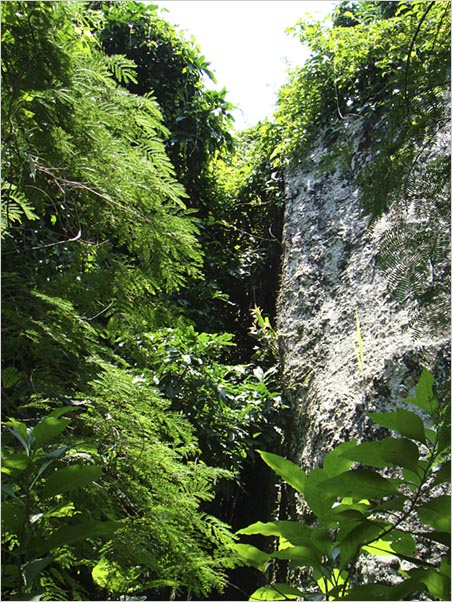 |
|
He follows, for years, with a binocular this only one clump of Cattleya forbesii, in the south face of the Pão-de-Açúcar Hill, in a vertical slope, turned to the west, next to wood. It is placed more or less 9 m above the point of observation. Careful, he was afraid of revealing the exact location and found, later, that someone had collected it. However he decided to share with us this discovery since the location exact was not informed. Now, he is less worried because he verified that the plant is easily found in commercial nurseries, it is cheap and thus there is no reason for collecting it in wild. Any one can cultivate it at home since the plant is healthy and well adapted to the pot. And those which resist in wild can stay there and having their beauty admired in their own environment years after years. |
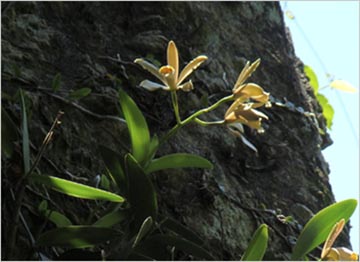 |
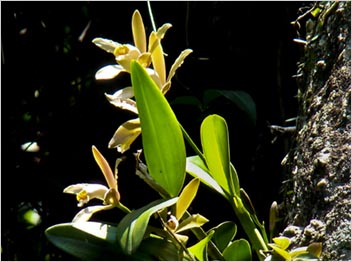 |
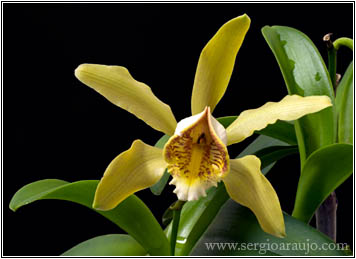 |
Cattleya forbesii is a species coming form the Atlantic Forest and has a wide distribution in the states of Minas Gerais, Paraná, Rio de Janeiro, Rio Grande do Sul, Santa Catarina,
São Paulo. It grows, in general, at the sea level, in the coastal regions, mainly in the restingas (sandbanks) or mangroves but it is also spread to higher elevations. It size can reach 25cm and the pseudobulbs are particularly thin (like cane). When it forms big clumps, it shows the delicate beauty of its flowers up to 12cm diameter. Its flowers, with a soft green apple scent (sometimes imperceptible), arise in number from 2 to 5 per floral stem and emerge from a sheath still green. It blooms since the springtime until summer. Its color varies from the green-apple to light chestnut. The lib is whitish and red veined with prominent keels in the diskal part. |
In the variety alba, the petals and sepals are green and the lip is white. Fritz Dungs collected a plant, in Gávea hill, 600m altitude and considered it as rosea variety (Hort), this plant, however, has been considered as a cross of Cattleya harrisoniana e Cattleya forbesii (Cattleya x venosa) (Fowlie). This species is known since the end of the 18th century but it has been introduced in culture by 1820. It has been described as Epidendrum pauper, by Vellozo, in 1790, however it was only published in 1825, when a new name had already been given, in 1823, by Lindley, in Collectanea Botanica, sub t. 33. |
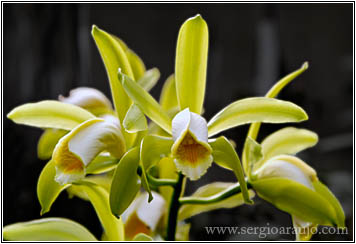 Cattleya forbesii alba |
Habitats in Rio de Janeiro city: This species grew in the outcrops and trees in Rio de Janeiro city, including Lagoa Rodrigues de Freitas, Copacabana and the lagoons of Jacarepaguá. The registers of collection show the surrounds of the city (Forbes, Lund e Gardner). In Lagoa Rodrigues de Freitas (Burchell) and on the stones around the margins (Beyrich), in Jacarepaguá, as rupicolous and epiphyte (Glaziou) and alsoCopacabana (Riedel). Associated species: Bifrenaria inodora, C. guttata, Cattleya harrisoniana, Catasetum hookerii, many species of Epidendrum e de Maxillaria, Oncidium flexuosum, Gongora sp. Natural hybrids: x dayana Rolfe - sine loco (C. guttata Lindl. x C. forbesii Lindl.) (842) x isabellae Rchb. f - (C. forbesii Lindl. x C. intermedia Grah.) (843) x venosa Rolfe - RJ (C. harrisoniana Batem. ex Lindl. x C. forbesii Lindl.) Hoehne (Album das Orchidaceaes Brasileiras - página 108 - 1930) cited the register of Cattleya forbesii x Cattleya leopoldii and Cattleya intermedia x Cattleya forbesii. João S. Decker (Cultura das Orquídeas no Brasil, página 69 - 1946) cited the occurrence of a natural hybrids between Cattleya forbesii e Cattleya bicolor. |
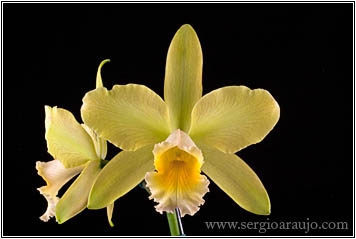 Blc. Cadmium Light 'Belle Glade' x (C. loddigesii alba x guttata alba) |
Very used in hybridizing, more than 1.300 hybrids have it in their genealogy. It transmits to the progeny the good grown, yellow and brown flowerse and the characteristic veins on the lip. Cultivation: It is an easy species well adapted to many conditions of culture but it needs a warm summer. It should be cultivate under a good luminosity and high humid conditions. It requires to have the water reduce during the winter but be careful with the thin pseudobulbs which tend to wrinkle if they don't receive enough water. |
Synonyms: Cattleya vestalis Hoffman - 1843 Cattleya fulva Beeer - 1854 Cattleya isopetala Beeer - 1854 Cattleya pauper (Vellozo) Stellfeld - 1945 Epidendrum pauper Vellozo - 1790 Epidendrum forbesii Rchb. f. - 1861 Maelenia paradoxa Du Mort - 1834 Bibliography: Ther Brazilian Bifoliate Cattleyas and Their Color Varieties - J. A. Fowlie, Orquídeas do estado da Guanabara , G. F. J. Pabst - Revista Orquídeas Março-Abril 1966 The Cattleyas and Their Relatives, Vol I. Carl L. Withner Album das Orchidaceaes Brasileiras, Hoehne, 1930 Cultura das Orquídeas no Brasil, 1946, João S. Decker Photos: Plínio Senna and Sergio Araujo |
|
Any
kind of reproduction (print, digital or anyone)
of any type of material of this site: texts,
layout, photos, images and others - is
strictly forbidden without previous written permission of the authors. Any solicitation or information by the e-mail:bo@sergioaraujo.com |